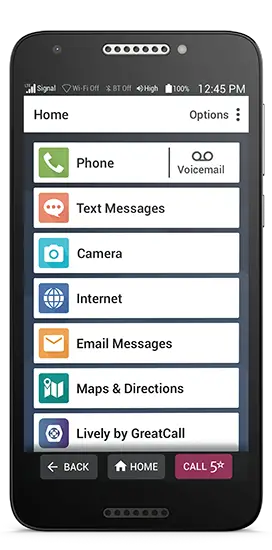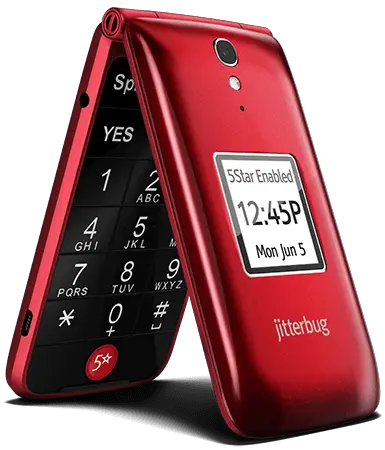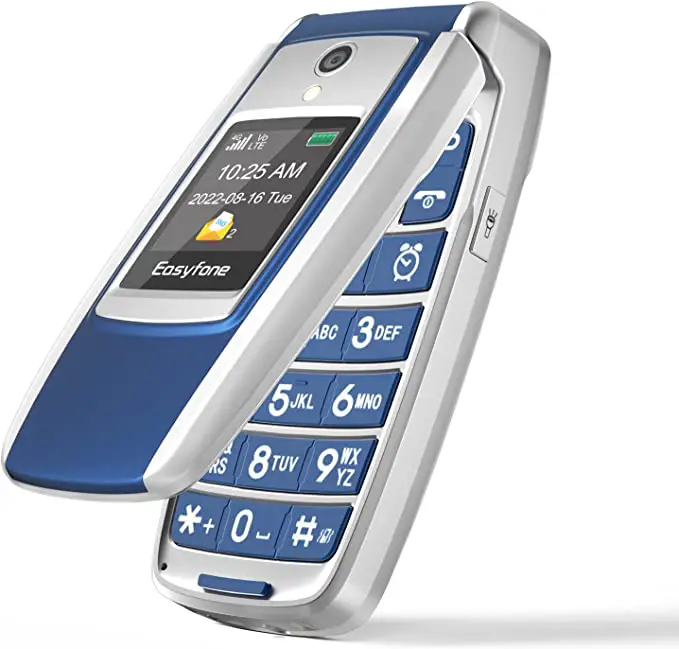While many older adults are excited to use the latest gadgets, some may find new technology overwhelming. Cell phones, in particular, have functionality that often makes them confusing or difficult to use for non-digital natives. When it comes to using cell phones, many older adults prefer simplicity.
Of all the phones we reviewed, here were our favorites:
Best Overall

Jitterbug Smart3
Designed for seniors
Internet, email, maps
Urgent concierge
Best For Emergencies

Jitterbug Flip
Basic features
Designed for seniors
Urgent concierge
Budget Friendly

Easyfone T300
Short battery life
Speed dial
Good speaker
Check out our detailed reviews below.
Jitterbug Smart from GreatCall – Best Overall

The Jitterbug Smart is for the modern senior that wants a simple display with all the key features that come with smartphones like Internet access, email, maps, and a high megapixel camera. Our favorite features, however, are all the other benefits that can come with Jitterbug devices like urgent care, GreatCall Link, and a personal operator.
Speakers
Front-facing speaker for clearer conversations
Battery life
Battery life is average with about 4 days on standby but far less with active usage.
Safety Features
All monthly plans come with the 5Star Urgent Response Service. The 5Star Service connects you to a trained emergency response agent who can confirm your location, evaluate the situation, and get you the help needed.
The optional add-on monthly services include access to the following benefits:
Urgent Care
Speak with a live nurse or doctor 24/7. You can even get prescriptions for common medication. No insurance plan or copay is necessary.
GreatCall Link
Great Call Link allows seniors and their family caregivers to receive emergency alerts, retrieve location, check the device status, and get caregiving support.
Personal Operator
Get assistance from a live concierge 24/7 by pressing the 0 key. The operator helps you with personal tasks like updating your calendar with appointments or updating your phone book. The operator is also able to call any residential/business number and instantly connect you to them. Lastly, you can use this feature to book a ride with the ridesharing app Lyft.
Cost
Check the retail cost of the phone on Amazon below. Occasionally, there are promotions.
- Monthly plans range from $19.99 to $34.99 per month
- The Basic plan is $19.99. It includes just basic service.
- The Preferred plan is $24.99. It includes basic service, Urgent Care, and GreatCall Link
- The Ultimate plan is $34.99. It includes everything in the Preferred plan plus Handset Replacement and a Personal Operator.
Additional Features
Accessibility features
List-based menu, large bright screen, typing by voice
Camera
Easy to use 13MP camera with LED flash
Jitterbug Flip from GreatCall – Best Phone for Emergency-Only

The Jitterbug Flip is perfect for those who prefer ultimate simplicity. The phone is designed for easy use. It has big buttons, a bright screen and a powerful speaker.
Speakers
The Jitterbug Flip features a loud and powerful speaker. The speaker allows you to talk hands-free.
Battery life
10 hours of talk time and days of standby time.
Safety Features
Like the Jitterbug Smart, the Jitterbug flip comes with many emergency feature.
All monthly plans come with the 5Star Urgent Response Service. The 5Star Service connects you to a trained emergency response agent who can confirm your location, evaluate the situation, and get you the help needed.
The optional premium add-on monthly services include access to the following benefits:
Urgent Care
Speak with a live nurse or doctor 24/7. You can even get prescriptions for common medication. No insurance plan or copay is necessary.
GreatCall Link
Great Call Link allows seniors and their family caregivers to receive emergency alerts, retrieve location, check the device status, and get caregiving support.
Personal Operator
Get assistance from a live concierge 24/7 by pressing the 0 key. The operator helps you with personal tasks like updating your calendar with appointments or updating your phone book. The operator is also able to call any residential/business number and instantly connect you to them. Lastly, you can use this feature to book a ride with the ridesharing app Lyft.
Cost
Check the retail cost of the phone on Amazon below. Occasionally, there are promotions.
- Monthly plans range from $19.99 to $34.99 per month
- The Basic plan is $19.99. It includes just basic service.
- The Preferred plan is $24.99. It includes basic service, Urgent Care, and GreatCall Link
- The Ultimate plan is $34.99. It includes everything in the Preferred plan plus Handset Replacement and a Personal Operator.
Additional Features
All of Jitterbug Flip’s features are designed to make it easier to use. The phone has large button, a simple Yes/No navigation menu, a magnifier, and a flash light.
Easyfone T300 – Budget Friendly

The Easyfone T300 runs on the T-Mobile network. It is a lightweight, durable flip phone with an extra-long battery life that makes it a perfect emergency phone companion. Its large buttons and font make it easy to use.
Speakers
The Easyfone T300 has a loud and clear speaker specifically designed for those who have trouble hearing. It is also compatible with some hearing aids.
Battery life
7 hours talk time. 96+ hours standby time.
Safety Features
Includes a SOS button that lets you send an emergency message to up to five numbers. This message continues until someone answers.
Cost
Plans start at $15 per month.
Additional Features
The Easyfone T300 is compatible with some hearing aids.
What to look for when choosing a cell phone for a senior
We looked at phones marketed specifically to seniors. When evaluating each phone, we considered the following factors:
Speakers
Speakers tend not to be a priority feature for many mainstream cell phone models. But, many older adults have difficulty hearing. Cell phones marketed specifically to older adults often come with speakers that are extra loud and compatible with hearing aids.
Battery life
When choosing a new cell phone consider the trade off between features and battery life. Feature rich smartphones require frequent charging. Flip phones have fewer features, but a far longer battery life. Do you mind needing to charge your cell phone every day? Will you use the features afforded by the smartphone or are you more likely to use the phone just for calling and texting?
Safety features
Phones marketed to seniors sometimes come with a built-in emergency response system. Typically, these phones have a dedicated button that allows the user to directly connect to an operator who can help with an immediate emergency (e.g. a fall), potential danger (e.g. a flat tire on a highway), or an anxiety causing situation (e.g. getting locked of your house).
Cost
Many phones have a low initial cost for the unit. But, some have an additional monthly fee of $35 or more for the cell service. These monthly fees can add up quickly; thereby, making the cheapest phone an expensive option in the long-term.
Additional features
Today’s new cell phones have many other features that you may want to prioritize based on your preferences and usage patterns.
For example, individuals with poor eyesight may want to consider the phone’s font size, screen brightness, and other accessibility options.
Almost all cell phones have cameras. Is the quality of the camera important to you? Do you want to use your new phone to take pictures of your grandchildren or capture life moments for Facebook?
Lastly, it’s important to consider the phone’s carrier compatibility. A lot of the phones marketed to seniors have their own carriers, but many are also compatible with the nation’s largest carriers (AT&T, Verizon, Sprint, etc.). If you are planning on adding your phone to your family’s plan, make sure it’s compatible with their carrier.



